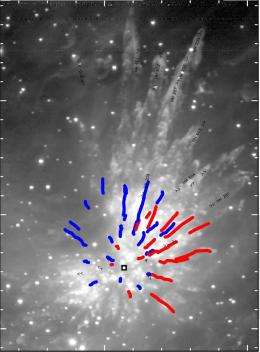The Explosive Disintegration of a Young Stellar System in Orion

(PhysOrg.com) -- The Orion Nebula is one of the most beautiful sights of the winter night sky, its gas and dust glowing from the intense ultraviolet radiation of a cluster of massive young stars.
At 1300 light-years away, the nebula is the closest nursery of massive stars to us. It is also a well-studied region, in part because astronomers recognize that the birth of massive stars involves a subset of the processes that produce all stars, while their deaths, as supernovae, will scatter into space the rich mix of chemical elements made in their nuclear furnaces, elements without which life could not exist.
The Orion Nebula is, however, still full of mysteries. Not far from its four bright stars -- the Trapezium -- is a luminous knot of three massive stars that shines with as much light as 100,000 suns (although at visible wavelengths it is completely obscured by dust). Surrounding the knot and extending radially outward from it over almost a light-year in length, like a fireworks display, are about forty narrow filaments of shocked material; furthermore the filaments contain gas seen moving at speeds of up to about 300,000 miles per hour. These fingers of material all point back to a central location near the knot. The energy in this explosive display is estimated to be as much as that from a hundred trillion suns; nothing else quite like it is known.
SAO astronomer Paul Ho and four of his colleagues used the Submillimeter Array and its precise spatial and velocity measuring capabilities to study the gas in the enigmatic jets of this region. They determined much of the three-dimensional structure of the explosion, with some jets moving towards us and others away from us. Not least, they found the spatial relationships of the jets to the shocked fingers, and to the bright knot whose component stars they confirmed are rapidly moving apart.
The astronomers arrive at a dramatic conclusion, one that had been hypothesized earlier by other astronomers studying this region: about 500 years ago a violent explosion of some kind disrupted the massive cluster, scattering the three stars in the knot apart, and ejecting the fingers and jets of material. What prompted the catastrophe is not understood but, although the phenomenon is unique as far as is currently known, similar events might be responsible for energetic activity in other galaxies too far away to probe with the detail possible in Orion.
Provided by Harvard-Smithsonian Center for Astrophysics (news : web)


















